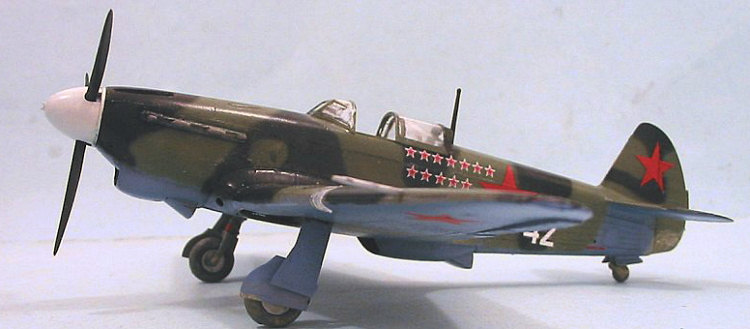
| KIT: | Eduard 1/48 Yak-1b |
| KIT #: | ? |
| PRICE: | $ |
| DECALS: | Five options |
| REVIEWER: | Tom Cleaver |
| NOTES: | Accurate Miniatures rebox with photo-etch |

| HISTORY |
The series of fighters designed by Alexsandr Yakovlev - Yak-1 to Yak-9 - were numerically the most important fighter aircraft used by the V-VS during the Second World War, and collectively may be the most widely-produced series of single-seat fighters in history (Note that I say series - the Bf-109 was a single type from beginning to end, with an airframe that was basically two different types, early and late, from the firewall aft, with a fuselage that was the same from firewall aft throughout. This is unlike the various Yak fighters which really were different from each other and not interchangeable.) The Yak fighters were primarily made of wood and otherwise lacked many of the refinements considered basic necessities in western fighters, but they commanded respect from their opponents.
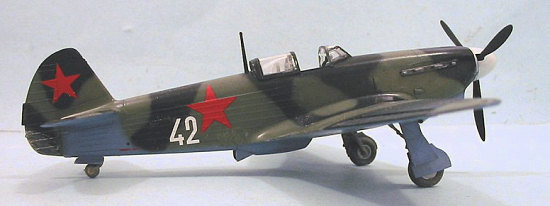 By 1938, the Red Air Force
was aware that the I-16 - which had been the most advanced single-seat fighter
in the world when it was first introduced in 1935 - was decidedly “long in the
tooth” and outclassed by even the early sub-types of the Messerschmitt Bf-109
which formed the main equipment of the Luftwaffe, which was the most
likely future opponent. The lack of a really high-performance liquid-cooled
engine - the M-105 being a license-built Hispano-Suiza 12Y of barely 1,000 h.p.
- meant that the new fighter designed by the Yakovlev bureau would have as light
a structure as could be done in wood, since the Soviet Union did not have the
production capability of mass-producing all-metal aircraft, and that the
airplane would be lightly armed.
By 1938, the Red Air Force
was aware that the I-16 - which had been the most advanced single-seat fighter
in the world when it was first introduced in 1935 - was decidedly “long in the
tooth” and outclassed by even the early sub-types of the Messerschmitt Bf-109
which formed the main equipment of the Luftwaffe, which was the most
likely future opponent. The lack of a really high-performance liquid-cooled
engine - the M-105 being a license-built Hispano-Suiza 12Y of barely 1,000 h.p.
- meant that the new fighter designed by the Yakovlev bureau would have as light
a structure as could be done in wood, since the Soviet Union did not have the
production capability of mass-producing all-metal aircraft, and that the
airplane would be lightly armed.
Yakovlev, who was only 32 and known within the Soviet aviation industry only for designing successful sporting and training aircraft prior to taking this assignment, created the I-26 in response to the request for proposals. It was so good that he won the 100,000 ruble Lenin Prize and a Zis automobile in April 1939, a mere two months after the first flight of the prototype.
Soon
designated Yak-1, the airplane had a wooden wing, with a welded steel tube
fuselage structure covered by detachable metal panels around the engine and by
plywood covered by doped fabric over the rest of the structure. The hydraulic
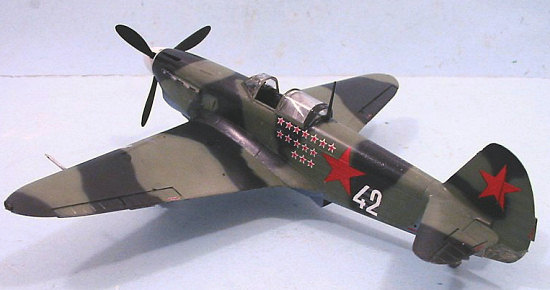 undercarriage was fully
retractable, including the tail wheel. The original armament comprised a 20mm
ShVAK cannon mounted to fire through the propeller hub, and 2 7.62mm ShKAS
machine guns above the engine.
undercarriage was fully
retractable, including the tail wheel. The original armament comprised a 20mm
ShVAK cannon mounted to fire through the propeller hub, and 2 7.62mm ShKAS
machine guns above the engine.
In June 1941 the Yak-1 passed its final state acceptance trials and was cleared for mass production. The main factory was in Moscow, and production deliveries did not commence until after the German invasion on June 22, 1941. With the massive German advances, production was disrupted while the factory was moved east into the Urals beginning in September. The drive demonstrated by Yakovlev is shown in the fact that the first production fighter off the new assembly line that October was completed three weeks after the arrival of the jigs from the original factory. Within 90 days, production was greater than had been achieved in Moscow. Thus, the Yak-1 did not reach the V-VS in appreciable numbers until the Spring of 1942, when it immediately proved its value.
What is known as the Yak-1b (despite this designation never being officially recognized) was created in late 1942 when the M-105PF engine was substituted for the M-105PA. This provided an increase in power to 1,210 h.p. from 1,100 h.p., but with a lower effective altitude due to the fact the second stage of the supercharge on the PF engaged at 8,860 feet as opposed to 13,120 ft for the PA. The twin ShKAS machine guns were replaced by a singer 12.7mm Beresin UBS weapon, and the rear fuselage decking was cut down to improve the pilot’s rear vision.
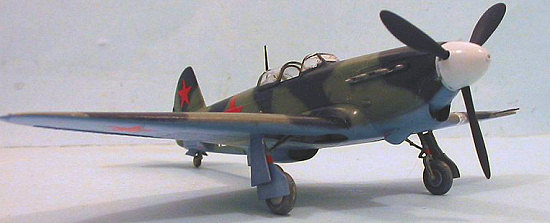 The Yak-1s first
demonstrated their ability in the fighting around Stalingrad from the late
summer of 1942 onward. The aircraft were the equal of the Bf-109 below 10,000
feet and were more maneuverable. As more and more Yak-1s reached operational
squadrons, the Luftwaffe found itself hard-pressed to mount any sort of aerial
offensive.
The Yak-1s first
demonstrated their ability in the fighting around Stalingrad from the late
summer of 1942 onward. The aircraft were the equal of the Bf-109 below 10,000
feet and were more maneuverable. As more and more Yak-1s reached operational
squadrons, the Luftwaffe found itself hard-pressed to mount any sort of aerial
offensive.
Yak-1s formed the initial equipment of the Normandie-Niemen Squadron of the Free French Air Force that fought on the Eastern Front beginning in 1943, and the French pilots considered the Yak to be the equal of the Spitfire several had flown in England and North Africa.
| THE KIT |
This kit was originally one of the first kits released by Accurate Miniatures in 1998. Even without any additional detail parts, the kit was universally lauded for its attention to detail and accuracy, and for the amount of detail provided in injection plastic. This release by Eduard effectively “gilds the lily” with a complete set of Eduard photoetch parts to give serious detail to the cockpit, as well as decals for no less than five different aircraft.
| CONSTRUCTION |
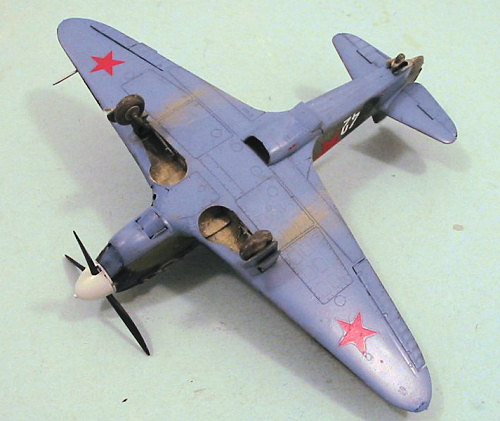 After looking at all the
photo-etch detail, and then looking at a model in my collection done from the
earlier Accurate Miniatures release, I decided to limit use of the photo-etch to
the instrument panel and the seatbelts, since the rest - while really excellent
- isn’t all that viewable once the cockpit is installed in the fuselage. Those
who want to do a serious “contest model” will make a different choice here.
After looking at all the
photo-etch detail, and then looking at a model in my collection done from the
earlier Accurate Miniatures release, I decided to limit use of the photo-etch to
the instrument panel and the seatbelts, since the rest - while really excellent
- isn’t all that viewable once the cockpit is installed in the fuselage. Those
who want to do a serious “contest model” will make a different choice here.
Basically, the model is best built in two sub-assemblies -fuselage and wing. Following the instructions results in trouble-free assembly, though I decided that while the model was designed to be assembled fuselage first, and then have the cockpit inserted through the opening for the wing, it would be easier not to take the risk of knocking off any of the photo-etch. Therefore, I assembled the cockpit first, attached it to the right fuselage half, then assembled the fuselage. The fit is so good that I only used Mr. Surfacer on the centerline seam on the lower fuselage.
With the kit assembled, it was time to go paint.
| COLORS & MARKINGS |
Painting:
I used Xtracrylix “RLM78 Light Blue” for the lower surface color, and Xtracrylix “RLM83 Light Green” and “Night Black” for the upper colors. When that was all dry, I applied a coat of Xtracrylix Gloss Varnish overall.
Decals:
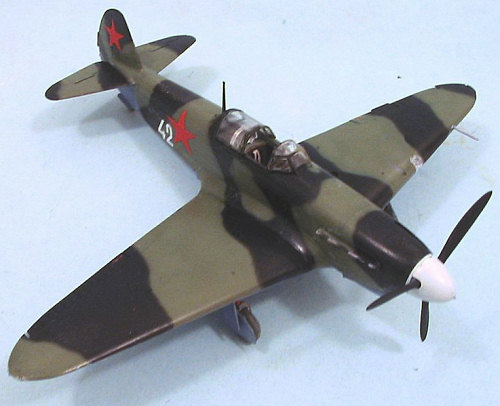 The Eduard decals went on
without problem. I was particularly glad that extra decals were provided to do
the victory stars in two-part application - white background, then the stars -
since the one-piece decal was misprinted just enough to be obviously off-center.
The Eduard decals went on
without problem. I was particularly glad that extra decals were provided to do
the victory stars in two-part application - white background, then the stars -
since the one-piece decal was misprinted just enough to be obviously off-center.
| FINAL CONSTRUCTION |
I gave the model a coat of Xtracrylix Satin Varnish. V-VS airplanes were given a thick coat of polish in the factory resulting in a glossy finish, and Satin Varnish looks right, not being “too glossy” - in 1/48 scale.
I assembled the landing gear, attached the prop, and unmasked the canopy, posing the sliding section in the open position.
| CONCLUSIONS |
This was a great kit when it was released nine years ago. Eduard has “gilded the lily” here to the point no other aftermarket items are necessary to create a super-detailed model of this important Soviet fighter. This is a limited-run release, so you should grab it where you can find it. Highly recommended.
March 2007
Thanks to Eduard for the review copy.
If you would like your product reviewed fairly and quickly by a site that has nearly 350,000 visitors a month, please contact me or see other details in the Note to Contributors.